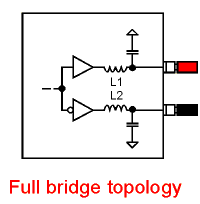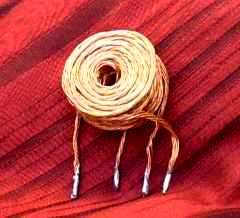In a class D audio amplifier, the output signal is a low-pass filtered version of the high-powered PWM voltage produced by a switching power stage. The bottom 20kHz of the signal spectrum is the audio signal. The high-frequency portion usually starts at a few 100kHz and consists of the switching frequency along with its harmonics and sidebands. These high-frequency components are a necessary by-product of trying to amplify a continuously variable signal using only two voltages. They need to be removed afterwards because it's only the audio we are interested in. A class D audio amplifier invariably ends in a passive LC filter intended to do just that.
A class D amplifier with full bridge topology has a balanced output and requires two inductors for each channel.

The ideal inductor (in terms of linearity) is an air-core one, but the size and number of turns required for typical Class-D operation usually makes it too expensive, so a core is normally used in order to reduce turns count and also provide a confined magnetic field that reduces radiated EMI. Powder cores or equivalent materials are the common choice. It can also be done with ferrite cores, but they must have a “gap” where energy is stored. Wire size must also be carefully chosen so DC losses are low (requiring thick wire) but also skin effect is reduced (AC resistance must also be low).
The amplifiers of the ROSSO's family use inductors made of Litz wires wounded on air. These inductors are designed for a low Q factor at high frequency so to achieve a good damping of the switching frequency. The low Q factor allows a flatter frequency response whereas the absence of a magnetic core prevents any signal distortion due to the magnetic core saturation. Finally, the large section of the wires limits the ohmic resistance of the coil allowing a tight control of the audio bass frequencies (high damping factor). The dual typology helps to reduce EMC issues.
